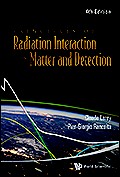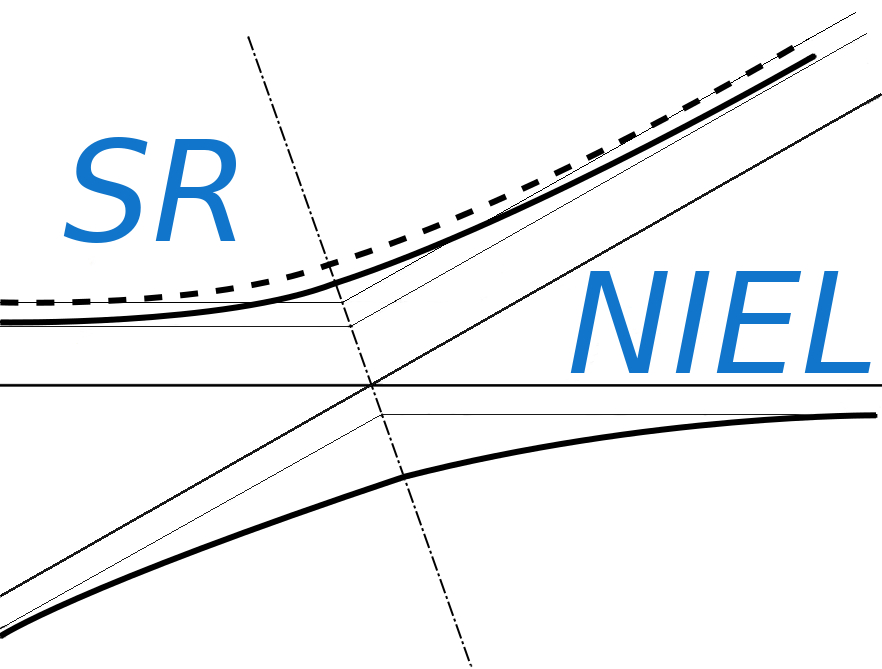NIEL Dose Dependence in GaAs Solar Cell
Baur et al. (2014) studied the reduction of solar-cells' maximum power resulting from irradiations with electrons and protons in both GaAs single junction and GaInP/GaAs/Ge triple junction solar cells. The results obtained by them indicate how (e.g., see Chapter 11 in [Leroy and Rancoita (2016)]) :
i) the dominant radiation damaging mechanism is due to atomic displacements,
ii) the relative maximum power degradation is almost independent of the type of incoming particle, i.e.,
iii) to a first approximation, the fitted semi-empirical function expressing the decrease of maximum power depends only on the absorbed NIEL dose, and
iv) the actual displacement threshold energy value (Ed =21 eV) accounts for annealing treatments, mostly due to self-annealing induced effects.
The above experimental results were confirmed by C. Baur et al. (2017) after irradiations of 3J solar cells with electrons and protons.
Thus, for a given type of solar cell, a unique maximum power degradation curve can be determined as a function of the absorbed NIEL dose. The latter expression allows one to predict the performance of those solar cells in space radiation environment. In [Baur et al. (2014)], the absorbed NIEL dose in units of MeV/g - imparted by particles with kinetic energy E - was obtained (e.g., see Eq. 4.150 at page 432 in [Leroy and Rancoita (2011)] (and Chapter 7 in [Leroy and Rancoita (2016)]) as:

where Φ is the fluence in cm-2 of traversing particles (electrons or protons in the current investigations) and ![]() is the corresponding displacement mass-stopping power of the medium.
is the corresponding displacement mass-stopping power of the medium.
Campesato et al. (2019) experimentally demonstrated that i) the dominant radiation damaging mechanism is due to atomic displacements and ii) the relative maximum power degradation is almost independent of the type of incoming particle (electrons, protons and neutrons).
References
 C. Baur, M. Gervasi, P. Nieminen, S. Pensotti, P.G. Rancoita, M. Tacconi, (2014), NIEL dose dependence for solar cells irradiated with electrons and protons, Proc. of the 14th ICATPP, September 23--27 2013, Villa Olmo, Como, Italy, S. Giani, C. Leroy, L. Price, P.G. Rancoita and R. Ruchti, Editors, World Scientific, Singapore, 698-713; ISBN: 978-981-4603-15-7; http://www.worldscientific.com/doi/pdf/10.1142/9789814603164_0111; http://arxiv.org/abs/1312.0402
C. Baur, M. Gervasi, P. Nieminen, S. Pensotti, P.G. Rancoita, M. Tacconi, (2014), NIEL dose dependence for solar cells irradiated with electrons and protons, Proc. of the 14th ICATPP, September 23--27 2013, Villa Olmo, Como, Italy, S. Giani, C. Leroy, L. Price, P.G. Rancoita and R. Ruchti, Editors, World Scientific, Singapore, 698-713; ISBN: 978-981-4603-15-7; http://www.worldscientific.com/doi/pdf/10.1142/9789814603164_0111; http://arxiv.org/abs/1312.0402
C. Baur et al. (2017), NIEL DOSE Analysis on Triple Junction cells 30% efficient and related single junctions, to appear in the proceedings of the 44th IEEE Photovoltaic Specialists Conference; see also C. Bauer et. (2017), Displacement Damage dose and DLTS Analyses on Triple and Single Junction solar cells irradiated with electrons and protons, arXiv:1704.06495 , avalable at https://arxiv.org/abs/1704.06495.
R. Campesato, C. Baur, M. Carta, M. Casale, D. Chiesa, M. Gervasi, E. Gombia, E. Greco, A. Kingma, M. Nastasi, E. Previtali, P.G. Rancoita, D. Rozza, E. Santoro, M. Tacconi (2019). NIEL Dose Analysis on triple and single junction InGaP/GaAs/Ge solar cells irradiated with electrons, protons and neutrons, to appear on Proceedings of the 2019 IEEE 46th Photovoltaic Specialist Conference (PVSC 46), June 16-21 (2019), Chicago (USA); available at https://arxiv.org/abs/1911.08900
 C. Leroy and P.G. Rancoita (2011), Principles of Radiation Interaction in Matter and Detection - 3rd Edition -,World Scientific, Singapore, ISBN-978-981-4360-51-7; http://www.worldscientific.com/worldscibooks/10.1142/8200 .
C. Leroy and P.G. Rancoita (2011), Principles of Radiation Interaction in Matter and Detection - 3rd Edition -,World Scientific, Singapore, ISBN-978-981-4360-51-7; http://www.worldscientific.com/worldscibooks/10.1142/8200 .
 C. Leroy and P.G. Rancoita (2016), Principles of Radiation Interaction in Matter and Detection - 4th Edition -, World Scientific. Singapore, ISBN-978-981-4603-18-8 (printed); ISBN.978-981-4603-19-5 (ebook).
C. Leroy and P.G. Rancoita (2016), Principles of Radiation Interaction in Matter and Detection - 4th Edition -, World Scientific. Singapore, ISBN-978-981-4603-18-8 (printed); ISBN.978-981-4603-19-5 (ebook).
https://www.worldscientific.com/worldscibooks/10.1142/9167#t=aboutBook; it is also partially accessible via google books.



